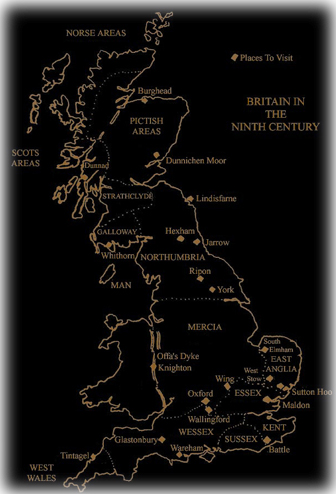 England In Anglo-Saxon Times
England In Anglo-Saxon Times
By 800AD the Anglo-Saxon kingdoms of Wessex, Mercia and Northumbria dominated what is now England. Wales was comprised of numerous small kingdoms, and Scotland dominated by the Picts and the Scots. From 793 frequent raids by "Vikings", normally Danes or Norse, largely destabilised all of the English kingdoms except Wessex. In 885 the raids changed to conquest, and the Danes rapidly took York, Strathclyde, Northumbria and Mercia. The following year a peace treaty between Alfred the Great, King of Wessex, and the Danes created the "Danelaw", an area of Danish rule north-west of a line from London to Chester.
In the early tenth century, Scottish kingdoms started to regain their territories, and Wessex began to expand into Mercia by 918. By 927, Wessex had taken York and in 937 the last hopes of breaking the domination of Wessex was lost when a Celtic-Norse Grand Alliance was defeated at the Battle of Brunanburh. By 959, England was "unified" politically under King Edgar of Wessex.
In 991, Danish raids recommenced. By 1016 King Cnut ("Canute") of Denmark was also King of England, but he left the English laws and institutions intact. In 1042 Edward the Confessor, of the Wessex royal line, became King of England. At this time England was threatened with invasion from Scandinavia and Normandy. As the Scandinavian threat seemed the greater, Edward allied with Duke William "the Bastard" of Normandy. After Edward's death early in 1066 Harold, on of Earl Godwine of Wessex, became King. King Harald Hardrada of Norway led a large invasion army landing in the North, which was defeated, but the Norman invasion was successful, Harold Godwineson was slain and the Normans took complete control of the administration of England.
 Oxford In Anglo-Saxon Times
Oxford In Anglo-Saxon Times
The name Oxford derives from the Anglo-Saxon word Oxnaforda (or Orsnaforda) meaning "ford of the oxen" - a place where oxen were driven across the river. The River Thames formed the frontier between Wessex and Mercia and Oxford was situated along one of the major trade-routes.
Around 700AD a monastery was founded by St. Frideswide on the site of today's Christ Church Cathedral. Its location by the River Thames made it accessible, strategically important and a good place for trade and meetings. The community around the monastery grew, and by 911 Oxford was part of a fortification system against the Danes.
The Danes were not just plundering invaders, they were also successful traders and settlers. By the turn of the first millennium Oxford had its own Danish community. The Danes resumed their raids against England in 991, and in 1002 a decree by King Æthelred II to the purpose of exterminating all Danes on English soil led to the St. Brice's Day massacre in Oxford and other cities. On that day some Danish settlers tried to seek refuge in St. Frideswide monastery as the English turned against them, but the monastery was set on fire and burned down.
Oxford paid a price for this massacre when it was sacked by Thorkell the Tall in 1009. Four years later Oxford submitted to King Sweyn of Denmark. The struggle for English freedom continued and in 1015 a great council was held in Oxford to organize the resistance against the Danes. However, two of the chief thegns were betrayed and murdered by the earl of Mercia Eadric Streona, who aided the Danish against the English to further his interests. Nonetheless Oxford remained loyal to King Æthelred's son Edmund Ironside, who became King in 1016. Edmund led the English against King Cnut of Denmark, but his reign was short. He was also betrayed Eadric Streona and was killed in Oxford in the year of his crowning.
King Cnut was also made King of England in 1016. Another great council held in Oxford in 1018 decided that the English laws of Edgar should apply to Danes and Saxons alike. King Cnut died in 1035 and was succeeded by his son Harold, who was apparently crowned in Oxford and died here four years later. In 1035 Cnut was succeeded by his sons Harold I and Harthacnut. The latter died in 1042, and the English restored Æthelred II's line by crowning his son Edward (the Confessor). With a few exceptions, by 1066 most West Midland thegns were Englishmen, and those of Norse descent had been absorbed into English society. Oxfordshire was a county in which the Leofricsons (the family of the old Earls of Mercia) and the Godwinesons vied for power. Both were highly influential, and Oxfordshire was probably characterized by dynastic struggles in the decade before the Conquest.
During the Early Mediæval period Oxford developed from a small ecclesiastic community to one of the largest towns in England.
